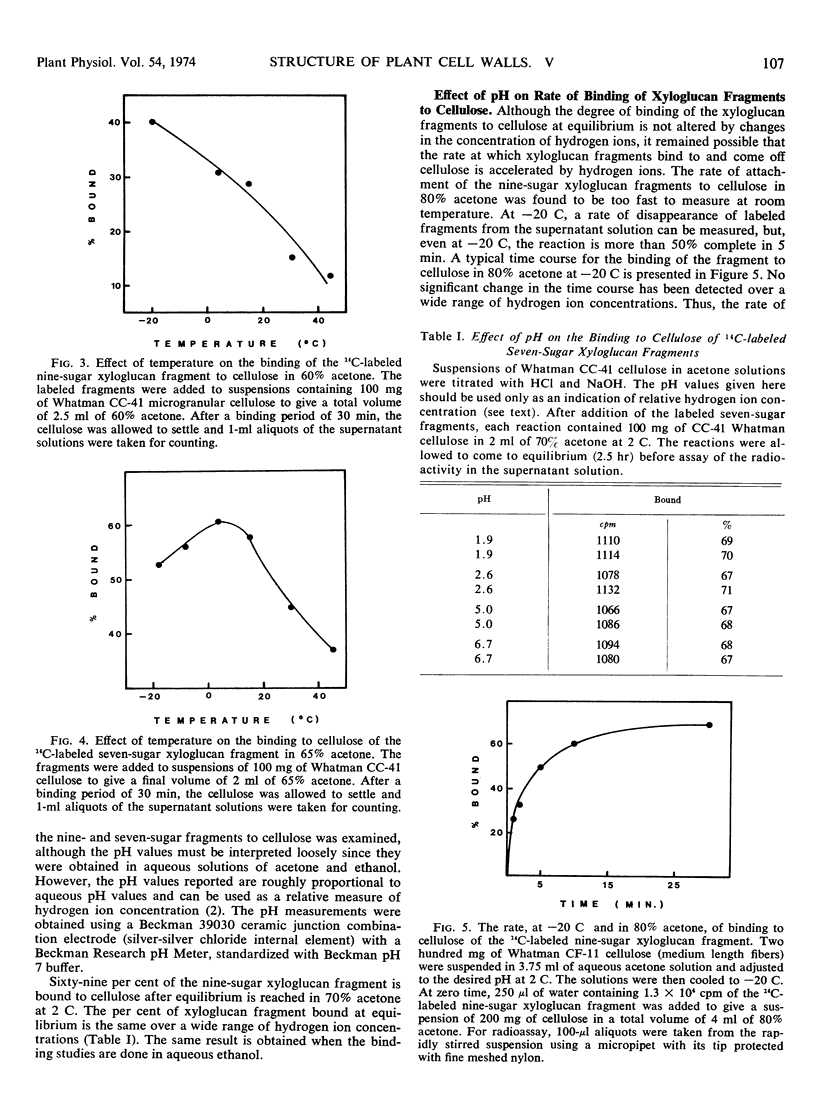Abstract
Cell wall strength is decreased by both auxin treatment and low pH. In a recently proposed model of the plant cell wall, xyloglucan polymers are hydrogen-bonded to cellulose fibrils, forming the only noncovalent link in the network of polymers which cross-link the cellulose fibers. The decreased strength of the cell wall seen upon lowering the pH might be due to an effect of hydrogen ions on the rate of xyloglucan creep along cellulose fibers. This paper investigates binding of xyloglucan fragments to cellulose. At equilibrium, the per cent of nine- and seven-sugar xyloglucan fragments which are bound to cellulose is sensitive to both temperature and the concentration of nonaqueous solvents. However, neither the per cent of xyloglucan fragments bound to cellulose at equilibrium, nor the rate at which the xyloglucan fragments bind to cellulose, is sensitive to changes in hydrogen ion concentration. These results support the hypothesis that, within the cell wall, xyloglucan chains are connected to cellulose fibers by hydrogen bonds, but these results suggest that this interconnection between xyloglucan and cellulose is unlikely to be the point within the wall which regulates the rate of cell elongation.
Full text
PDF



Selected References
These references are in PubMed. This may not be the complete list of references from this article.
- Bauer W. D., Talmadge K. W., Keegstra K., Albersheim P. The Structure of Plant Cell Walls: II. The Hemicellulose of the Walls of Suspension-cultured Sycamore Cells. Plant Physiol. 1973 Jan;51(1):174–187. doi: 10.1104/pp.51.1.174. [DOI] [PMC free article] [PubMed] [Google Scholar]
- Fisher M. L., Albersheim P. Characterization of a H Efflux from Suspension-cultured Plant Cells. Plant Physiol. 1974 Mar;53(3):464–468. doi: 10.1104/pp.53.3.464. [DOI] [PMC free article] [PubMed] [Google Scholar]
- Rayle D. L., Haughton P. M., Cleland R. An in vitro system that simulates plant cell extension growth. Proc Natl Acad Sci U S A. 1970 Dec;67(4):1814–1817. doi: 10.1073/pnas.67.4.1814. [DOI] [PMC free article] [PubMed] [Google Scholar]
- Wilder B. M., Albersheim P. The Structure of Plant Cell Walls: IV. A Structural Comparison of the Wall Hemicellulose of Cell Suspension Cultures of Sycamore (Acer PseudoPlatAnus) and of Red Kidney Bean (Phaseolus Vulgaris). Plant Physiol. 1973 May;51(5):889–893. doi: 10.1104/pp.51.5.889. [DOI] [PMC free article] [PubMed] [Google Scholar]


